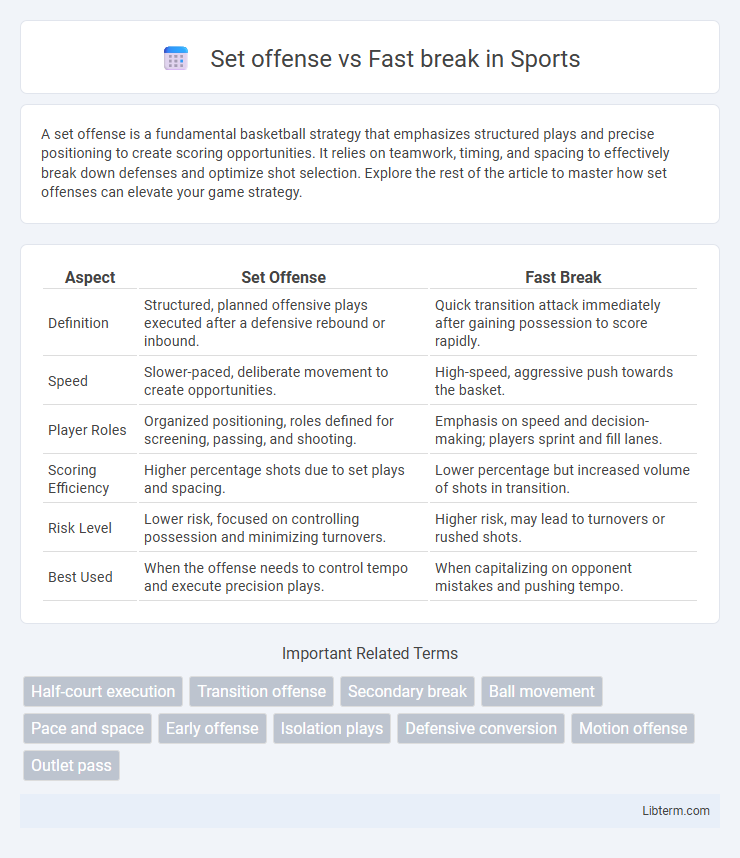A set offense is a fundamental basketball strategy that emphasizes structured plays and precise positioning to create scoring opportunities. It relies on teamwork, timing, and spacing to effectively break down defenses and optimize shot selection. Explore the rest of the article to master how set offenses can elevate your game strategy.
Table of Comparison
| Aspect | Set Offense | Fast Break |
|---|---|---|
| Definition | Structured, planned offensive plays executed after a defensive rebound or inbound. | Quick transition attack immediately after gaining possession to score rapidly. |
| Speed | Slower-paced, deliberate movement to create opportunities. | High-speed, aggressive push towards the basket. |
| Player Roles | Organized positioning, roles defined for screening, passing, and shooting. | Emphasis on speed and decision-making; players sprint and fill lanes. |
| Scoring Efficiency | Higher percentage shots due to set plays and spacing. | Lower percentage but increased volume of shots in transition. |
| Risk Level | Lower risk, focused on controlling possession and minimizing turnovers. | Higher risk, may lead to turnovers or rushed shots. |
| Best Used | When the offense needs to control tempo and execute precision plays. | When capitalizing on opponent mistakes and pushing tempo. |
Introduction to Set Offense and Fast Break
Set offense emphasizes structured plays, strategic ball movement, and player positioning to create high-percentage scoring opportunities through coordinated team efforts. Fast break exploits rapid transitions from defense to offense, leveraging speed and quick decision-making to score before the opposing defense can set up. Understanding these distinct approaches enhances a team's versatility and efficiency on the basketball court.
Core Principles of Set Offense
Set offense in basketball emphasizes structured play, with players executing predetermined roles and movements to create high-percentage scoring opportunities through precise ball movement and spacing. Core principles include maintaining proper spacing to stretch the defense, using screens effectively to free shooters or create driving lanes, and employing patient ball circulation to exploit defensive weaknesses. This strategic approach contrasts with fast break tactics, which rely on speed and quick transitions to score before the defense can set.
Fundamentals of the Fast Break
The fundamentals of the fast break include quick outlet passing, superior court vision, and relentless sprinting to outpace defenders before they set up a half-court defense. Successful fast breaks rely on three key phases: the outlet pass to the trailing teammates, efficient ball handling to maintain speed, and precise finishing at the basket through layups or open jump shots. Mastering these elements enhances transition scoring opportunities and capitalizes on defensive lapses.
Advantages of Running Set Plays
Running set plays in basketball provides structured spacing and precise player movement, increasing scoring efficiency by exploiting defensive weaknesses. These plays enhance team coordination and maximize high-percentage shot opportunities through rehearsed actions. Set offenses also improve ball control, reducing turnovers compared to fast break situations.
Benefits of an Effective Fast Break
An effective fast break in basketball maximizes scoring opportunities by exploiting defensive lapses before opponents can set up their defense, increasing the likelihood of high-percentage shots. It accelerates game tempo, forces turnovers, and capitalizes on player speed and decision-making, often leading to easy baskets or mismatches. Teams with proficient fast breaks often see improved offensive efficiency and increased scoreboard pressure on opponents, highlighting its strategic advantage over a slower, set offense.
Key Differences Between Set Offense and Fast Break
Set offense emphasizes structured plays and coordinated player movements to create scoring opportunities through precise passing and strategic spacing. Fast break relies on rapid transition and speed, aiming to exploit defensive gaps immediately after gaining possession for quick scoring chances. The key difference lies in pace and organization: set offense is deliberate and methodical, while fast break prioritizes speed and opportunistic attacks.
When to Use Set Offense vs Fast Break
Set offense is best used when the team needs to control the pace and execute structured plays against a well-organized defense, often during late game situations or after an opponent timeout. Fast break should be employed when the defense is unsettled or during transitions, capitalizing on speed and quick ball movement immediately after gaining possession. Coaches typically choose set offense to minimize turnovers and maximize shot quality, while fast break is ideal for exploiting defensive mismatches and fast scoring opportunities.
Common Mistakes in Each Approach
Set offense often suffers from poor spacing and predictable player movements, which allow defenses to anticipate plays and disrupt ball flow. Fast break mistakes commonly include rushed decisions and improper outlet passes, leading to turnovers and missed scoring opportunities. Both approaches benefit from improved court awareness and quick communication to optimize execution and maintain scoring efficiency.
Impact on Team Dynamics and Player Roles
Set offense promotes structured team dynamics by emphasizing coordinated movements and predetermined plays, fostering clear player roles and strategic positioning. Fast break relies on rapid transitions and improvisation, requiring players to adopt versatile roles and make quick decisions under pressure. The contrast in pacing influences communication patterns and on-court leadership, shaping overall team cohesion and adaptability during games.
Choosing the Best Strategy for Your Team
Choosing between set offense and fast break hinges on your team's strengths and game tempo preferences. Set offense emphasizes structured plays and precise ball movement, ideal for teams with strong shooting and disciplined execution. Fast breaks exploit quick transitions and speed, benefiting squads with athletic players who excel in creating scoring opportunities before the defense sets up.
Set offense Infographic

 libterm.com
libterm.com